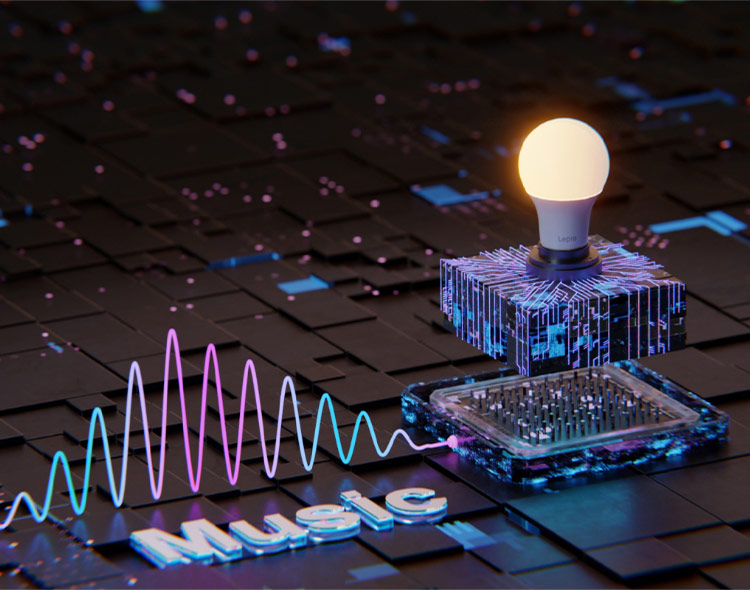LightBeats™ vs Normal Music Sync Technology
The amplitude signal of the sound wave doesn't directly reflect human perception of loudness, which necessitates advanced algorithms to achieve a more accurate and synchronized audiovisual experience. LightBeats takes into consideration the non-linear relationship between perceived loudness and physical amplitude of sound waves, the algorithm simulates the human auditory nerve system to get a accurate loudness.
Get the sound signals
Sound sources generate sound waves that propagate through the air. When these sound waves reach a microphone or audio input device, they are converted into corresponding electrical signals. The amplitude component of these signals represents the intensity or sound pressure level of the sound.
Analyze the source of the sound
The algorithm determines the source of the sound, whether it is in a free sound field, diffuse sound field, or playing through headphones. It then applies different simulation methods based on the specific characteristics and perceived differences of these sound fields.
Match different impulse response filter for different source
Simulate the human auditory nerve system
The algorithm calculates the perceived loudness for each ear separately, considering the binaural masking effects - when sound is heard separately in both ears, the perceived loudness is lower than the sum of the loudness values in both ears.
Consider the binaural masking effects
Match sound and lighting effects
If the peak-to-valley difference in subjective loudness exceeds a certain threshold, a blink of light can be triggered.
Match light with stable sound
If the sound remains relatively stable over a certain duration, various lighting effects such as slow ripple patterns can be applied, especially when using linear lighting devices.

More Accurate Audiovisual Sync:
Based on the subjective perception of the user's loudness, rather than machine-detected sound wave amplitudes, the light effects can truly match the rhythm and intensity of the music, providing users with a more accurate and personalized audiovisual experience, leading to greater satisfaction and enjoyment.
Simulate Human Auditory Nervous System:
By using algorithms to simulate the human auditory nervous system, the obtained sound signals are transformed into subjective perceptions of loudness that align with the human experience.
Multiple Light Effects:
To cater to various music rhythms, LightBeats offers a wide range of lighting effects. Whether it's intense rock music or gentle ambient tunes, LightBeats ensures a fully immersive experience that complements and enhances every musical style.
Group Music Sync:
LightBeats allows for up to 200 devices to synchronize harmoniously. This enables the creation of a seamless and immersive ambiance throughout an entire home, where multiple devices pulsate in perfect rhythm together.
Immersive Music Experience:
Making music more than just an auditory experience, but rather an immersive combination of sight and sound, allows you to enter a whole new world where you can truly feel the music.
The amplitude signal of the sound wave doesn't directly reflect human perception of loudness, which necessitates advanced algorithms to achieve a more accurate and synchronized audiovisual experience. LightBeats takes into consideration the non-linear relationship between perceived loudness and physical amplitude of sound waves, the algorithm simulates the human auditory nerve system to get a accurate loudness.
Get the sound signals
Sound sources generate sound waves that propagate through the air. When these sound waves reach a microphone or audio input device, they are converted into corresponding electrical signals. The amplitude component of these signals represents the intensity or sound pressure level of the sound.
Analyze the source of the sound
The algorithm determines the source of the sound, whether it is in a free sound field, diffuse sound field, or playing through headphones. It then applies different simulation methods based on the specific characteristics and perceived differences of these sound fields.
Match different impulse response filter for different source
Simulate the human auditory nerve system
The algorithm calculates the perceived loudness for each ear separately, considering the binaural masking effects - when sound is heard separately in both ears, the perceived loudness is lower than the sum of the loudness values in both ears.
Consider the binaural masking effects
Match sound and lighting effects
If the peak-to-valley difference in subjective loudness exceeds a certain threshold, a blink of light can be triggered.
Match light with stable sound
If the sound remains relatively stable over a certain duration, various lighting effects such as slow ripple patterns can be applied, especially when using linear lighting devices.

More Accurate Audiovisual Sync:
Based on the subjective perception of the user's loudness, rather than machine-detected sound wave amplitudes, the light effects can truly match the rhythm and intensity of the music, providing users with a more accurate and personalized audiovisual experience, leading to greater satisfaction and enjoyment.

Simulate Human Auditory Nervous System:
By using algorithms to simulate the human auditory nervous system, the obtained sound signals are transformed into subjective perceptions of loudness that align with the human experience.

Multiple Light Effects:
To cater to various music rhythms, LightBeats offers a wide range of lighting effects. Whether it's intense rock music or gentle ambient tunes, LightBeats ensures a fully immersive experience that complements and enhances every musical style.

Group Music Sync:
LightBeats allows for up to 200 devices to synchronize harmoniously. This enables the creation of a seamless and immersive ambiance throughout an entire home, where multiple devices pulsate in perfect rhythm together.

Immersive Music Experience:
Making music more than just an auditory experience, but rather an immersive combination of sight and sound, allows you to enter a whole new world where you can truly feel the music.
Recommended Scenarios
LightBeats' capabilities can be utilized in any scenario where sound serves as an active element. Its versatile features are designed to enhance and sync with the sound, creating an engaging and immersive atmosphere for everyone involved.

Special Occasions and Holidays:Enrich every special occasion and holidays with music and lighting.

Entertainment and Parties:Choose your favorite music and let LightBeats energize the environment.

Live Performances:Let LightBeats become your lighting designer and make the lights dance to the rhythm of your music.

Listen to Music:LightBeats' synchronized sound-light effects will transport you into a whole new world of immersion.
Disclaimer
- LightBeats™ technology model is currently at version 1.0 and may undergo future iterations and updates.
- Lepro retains full rights to interpret and explain this technology.


